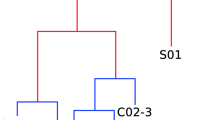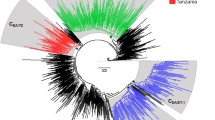Abstract
One of the cornerstones in combating the HIV pandemic is the ability to assess the current state and evolution of local HIV epidemics. This remains a complex problem, as many HIV infected individuals remain unaware of their infection status, leading to parts of HIV epidemics being undiagnosed and under-reported. We first present a method to learn epidemiological parameters from phylogenetic trees, using approximate Bayesian computation (ABC). The epidemiological parameters learned as a result of applying ABC are subsequently used in epidemiological models that aim to simulate a specific epidemic. Secondly, we continue by describing the development of a tree statistic, rooted in coalescent theory, which we use to relate epidemiological parameters to a phylogenetic tree, by using the simulated epidemics. We show that the presented tree statistic enables differentiation of epidemiological parameters, while only relying on phylogenetic trees, thus enabling the construction of new methods to ascertain the epidemiological state of an HIV epidemic. By using genetic data to infer epidemic sizes, we expect to enhance our understanding of the portions of the infected population in which diagnosis rates are low.
These authors contributed equally to this work.
Access this chapter
Tax calculation will be finalised at checkout
Purchases are for personal use only
Similar content being viewed by others
References
UNAIDS. Fact sheet - latest global and regional statistics on the status of the aids epidemic, July 2017
Hightow-Weidman, L.B., Golin, C.E., Green, K., Shaw, E.N.P., MacDonald, P.D.M., Leone, P.A.: Identifying people with acute HIV infection: demographic features, risk factors, and use of health care among individuals with AHI in North Carolina. AIDS Behav. 13(6), 1075–1083 (2009)
Burton, G.F., Keele, B.F., Estes, J.D., Thacker, T.C., Gartner, S.: Follicular dendritic cell contributions to HIV pathogenesis. In: Seminars in Immunology, vol. 14, pp. 275–284. Elsevier (2002)
Theys, K., Libin, P., Pineda-Pena, A.-C., Nowe, A., Vandamme, A.-M., Abecasis, A.B.: The impact of HIV-1 within-host evolution on transmission dynamics. Curr. Opin. Virol. 28, 92–101 (2018)
Begier, E.M., et al.: Undiagnosed HIV infection among New York City jail entrants, 2006: results of a blinded serosurvey. JAIDS J. Acquir. Immune Defic. Syndr. 54(1), 93–101 (2010)
van Sighem, A., et al.: Estimating HIV incidence, time to diagnosis, and the undiagnosed HIV epidemic using routine surveillance data. Epidemiology 26(5), 653 (2015)
Mammone, A., et al.: How many people are living with undiagnosed HIV infection? an estimate for Italy, based on surveillance data. AIDS 30(7), 1131 (2016)
Vajpayee, M., Mohan, T.: Current practices in laboratory monitoring of HIV infection. Indian J. Med. Res. 134(6), 801 (2011)
Sunnåker, M., Busetto, A.G., Numminen, E., Corander, J., Foll, M., Dessimoz, C.: Approximate bayesian computation. PLoS Comput. Biology 9(1), e1002803 (2013)
Ridley, M.: Evolution. John Wiley & Sons Incorporated (2009)
Hennig, W.: Phylogenetic systematics. Ann. Rev. Entomol. 10(1), 97–116 (1965)
Salemi, M., Lemey, P., Vandamme, A.-M.: The Phylogenetic Handbook: A Practical Approach to Phylogenetic Analysis and Hypothesis Testing. Cambridge University Press, Cambridge (2009)
Felsenstein, J.: Inferring Phylogenies, vol. 2. Sinauer associates Sunderland, MA (2004)
Chor, B., Tuller, T.: Finding a maximum likelihood tree is hard. J. ACM (JACM) 53(5), 722–744 (2006)
Roch, S.: A short proof that phylogenetic tree reconstruction by maximum likelihood is hard. IEEE/ACM Trans. Comput. Biol. Bioinform. (TCBB) 3(1), 92 (2006)
Freed, E.O.: HIV-1 replication. Somatic Cell Mol. Genet. 26(1–6), 13–33 (2001)
Gallo, R., Wong-Staal, F., Montagnier, L., Haseltine, W.A., Yoshida, M.: HIV/HTLV gene nomenclature. Nature 333(6173), 504–504 (1988)
Kindt, T.J., Goldsby, R.A., Osborne, B.A., Kuby, J.: Kuby immunology. Macmillan (2007)
Rambaut, A., Posada, D., Crandall, K.A., Holmes, E.C.: The causes and consequences of HIV evolution. Nature reviews. Genetics 5(1), 52 (2004)
Cohen, M.S., Hellmann, N., Levy, J.A., DeCock, K., Lange, J.: The spread, treatment, and prevention of HIV-1: evolution of a global pandemic. J. Clin. Inv. 118(4), 1244 (2008)
Fauci, A.S., Pantaleo, G., Stanley, S., Weissman, D.: Immunopathogenic mechanisms of HIV infection. Ann. Internal Medi. 124(7), 654–663 (1996)
Ferguson, M.R., Rojo, D.R., von Lindern, J.J., O’Brien, W.A.: HIV-1 replication cycle. Clin. Lab. Med. 22(3), 611–635 (2002)
Lemey, P., Rambaut, A., Pybus, O.G.: HIV evolutionary dynamics within and among hosts. AIDs Rev. 8(3), 125–140 (2006)
Li, W.-H., Tanimura, M., Sharp, P.M.: Rates and dates of divergence between AIDS virus nucleotide sequences. Mol. Biol. Evol. 5(4), 313–330 (1988)
Wei, X., et al.: Viral dynamics in human immunodeficiency virus type 1 infection. Nature 373(6510), 117–122 (1995)
Ho, D.D., Neumann, A.U., Perelson, A.S., Chen, W., Leonard, J.M., Markowitz, M.: Rapid turnover of plasma virions and CD4 lymphocytes in HIV-1 infection. Nature 373(6510), 123–126 (1995)
Holmes, E.C.: On the origin and evolution of the human immunodeficiency virus (HIV). Biol. Rev. 76(2), 239–254 (2001)
Hahn, B.H., Shaw, G.M., De, K.M., Sharp, P.M., et al.: AIDS as a zoonosis: scientific and public health implications. Science 287(5453), 607–614 (2000)
Sharp, P.M., Hahn, B.H.: Origins of HIV and the AIDS pandemic. Cold Spring Harbor Perspect. Med. 1(1), 006841 (2011)
de Silva, T.I., Cotten, M., Rowland-Jones, S.L.: HIV-2: the forgotten AIDS virus. Trends Microbiol. 16(12), 588–595 (2008)
Merson, M.H., O’Malley, J., Serwadda, D., Apisuk, C.: The history and challenge of HIV prevention. Lancet 372(9637), 475–488 (2008)
Peeters, M., Gueye, A., Mboup, S., Bibollet-Ruche, F., Ekaza, E., Mulanga, C., Ouedrago, R., Gandji, R., Mpele, P., Dibanga, G., et al.: Geographical distribution of HIV-1 group O viruses in Africa. Aids 11(4), 493–498 (1997)
Vallari, A., et al.: Four new HIV-1 group N isolates from cameroon: prevalence continues to be low. AIDS Res. Hum. Retroviruses 26(1), 109–115 (2010)
Vallari, A., Holzmayer, V., Harris, B., Yamaguchi, J., Ngansop, C., Makamche, F., Mbanya, D., Kaptué, L., Ndembi, N., Gürtler, L., et al.: Confirmation of putative HIV-1 group P in Cameroon. J. Virol. 85(3), 1403–1407 (2011)
Goudsmit, J.: Viral sex: The nature of AIDS. Oxford University Press on Demand (1997)
Buonaguro, L., Tornesello, M.L., Buonaguro, F.M.: Human immunodeficiency virus type 1 subtype distribution in the worldwide epidemic: pathogenetic and therapeutic implications. J. Virol. 81(19), 10209–10219 (2007)
Taylor, B.S., Sobieszczyk, M.E., McCutchan, F.E., Hammer, S.M.: The challenge of HIV-1 subtype diversity. New Engl. J. Med. 358(15), 1590–1602 (2008)
Santiago, M.L., et al.: Simian immunodeficiency virus infection in free-ranging sooty mangabeys (Cercocebus atys atys) from the Tai Forest, Cote d’Ivoire: implications for the origin of epidemic human immunodeficiency virus type 2. J. Virol. 79(19), 12515–12527 (2005)
Baeten, J.M., et al.: HIV-1 subtype D infection is associated with faster disease progression than subtype A in spite of similar plasma HIV-1 loads. J. Infect. Dis. 195(8), 1177–1180 (2007)
Pineda-Peña, A.-C., et al.: Automated subtyping of HIV-1 genetic sequences for clinical and surveillance purposes: performance evaluation of the new REGA version 3 and seven other tools. Infect. Genet. Evol. 19, 337–348 (2013)
Libin, P., Versbraegen, N., Cuypers, L., Theys, K., Nowé, A.: An automated maximum likelihood method for classifying virus sequences (2016)
Brauer, F.: Compartmental models in epidemiology. Mathematical Epidemiology. LNM, vol. 1945, pp. 19–79. Springer, Heidelberg (2008). https://doi.org/10.1007/978-3-540-78911-6_2
Stacy, S., Black, A., Bedford, T.: Using the coalescent framework to detect missed infections in phylogenetic trees (2016)
Kingman, J.F.C.: The coalescent. Stochastic processes and their applications 13(3), 235–248 (1982)
Diniz, A.: Portugal infeção VIH, SIDA e tuberculose em números, 2015. Portugal Infeção VIH, SIDA e Tuberculose em números, 2015, pp. 5–70 (2015)
Abecasis, A.B., et al.: HIV-1 subtype distribution and its demographic determinants in newly diagnosed patients in europe suggest highly compartmentalized epidemics. Retrovirology 10(1), 7 (2013)
Libin, P., et al.: RegaDB: community-driven data management and analysis for infectious diseases. Bioinformatics 29(11), 1477–1480 (2013)
Pineda-Peña, A.-C., et al.: Automated subtyping of HIV-1 genetic sequences for clinical andsurveillance purposes: performance evaluation of the new rega version 3 andseven other tools. Infection, Genetics Evol. 19, 337–348 (2013)
Carlos, L., et al.: A standardized framework for accurate, high-throughput genotyping of recombinant and non-recombinant viral sequences. Nucleic Acids Res. 37(suppl\_2), W634–W642 (2009)
Katoh, K., Misawa, K., Kuma, K., Miyata, T.: MAFFT: a novel method for rapid multiple sequence alignment based on fast fourier transform. Nucleic Acids Res. 30(14), 3059–3066 (2002)
Stamatakis, A.: RAxML version 8: a tool for phylogenetic analysis and post-analysis of large phylogenies. Bioinformatics 30(9), 1312–1313 (2014)
Poon, A.F.Y.: Phylodynamic inference with kernel ABC and its application to HIV epidemiology. Mol. Biol. Evol. 32(9), 2483–2495 (2015)
Libin, P., Hernalsteen, L., Theys, K., Gomes, P., Abecasis, A., Nowe, A.: Bayesian inference of set-point viral load transmission models. In: 30th Benelux Conference on Artificial Intelligence, pp. 107–121 (2018)
Poon, A.F.Y., Walker, L.W., Murray, H., McCloskey, R.M., Harrigan, P.R., Liang, R.H.: Mapping the shapes of phylogenetic trees from human and zoonotic RNA viruses. PLoS One 8(11), e78122 (2013)
Rasmussen, D.A., Volz, E.M., Koelle, K.: Phylodynamic inference for structured epidemiological models. PLoS Comput. Biolo. 10(4), e1003570 (2014)
Volz, E.M.: Complex population dynamics and the coalescent under neutrality. Genetics 190(1), 187–201 (2012)
Volz, E.M.: Estimating HIV transmission rates with rcolgem (2014). Accessed Aug 2017
Volz, E.M.: Simulating genealogies with an epidemiological coalescent model using rcolgem (2015). Accessed Aug 2017
Ratmann, O., et al.: Phylogenetic tools for generalized HIV-1 epidemics: findings from the PANGEA-HIV methods comparison. Mol. Biol. Evol. 34(1), 185–203 (2017)
Libin, P., et al.: PhyloGeoTool: interactively exploring large phylogenies in an epidemiological context. Bioinformatics 33(24), 3993–3995 (2017)
Stuessy, T.F., König, C.: Patrocladistic classification. Taxon 57(2), 594–601 (2008)
Acknowledgments
Pieter Libin was supported by a PhD grant of the FWO (Fonds Wetenschappelijk Onderzoek Vlaanderen) and a grant of the VUB research council (VUB/OZR2714).
Author information
Authors and Affiliations
Corresponding authors
Editor information
Editors and Affiliations
Rights and permissions
Copyright information
© 2020 Springer Nature Switzerland AG
About this paper
Cite this paper
Libin, P., Versbraegen, N., Abecasis, A.B., Gomes, P., Lenaerts, T., Nowé, A. (2020). Towards a Phylogenetic Measure to Quantify HIV Incidence. In: Bogaerts, B., et al. Artificial Intelligence and Machine Learning. BNAIC BENELEARN 2019 2019. Communications in Computer and Information Science, vol 1196. Springer, Cham. https://doi.org/10.1007/978-3-030-65154-1_3
Download citation
DOI: https://doi.org/10.1007/978-3-030-65154-1_3
Published:
Publisher Name: Springer, Cham
Print ISBN: 978-3-030-65153-4
Online ISBN: 978-3-030-65154-1
eBook Packages: Computer ScienceComputer Science (R0)




